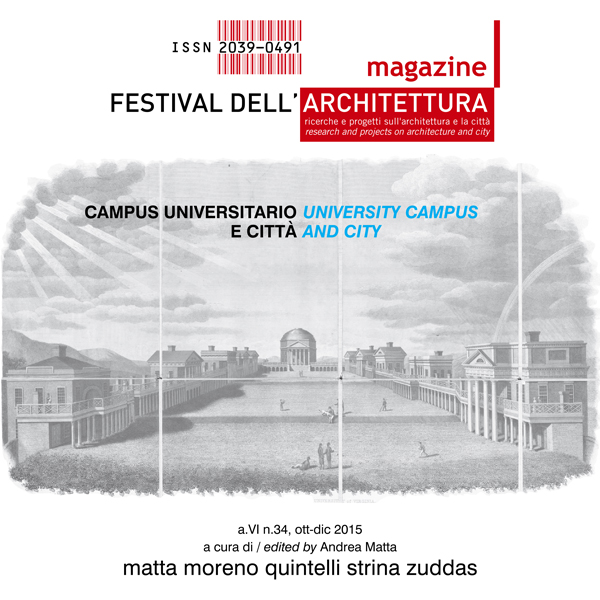Articoli
Pubblicato 2015-10-01
Parole chiave
- Shadrach Woods,
- Giancarlo De Carlo,
- Mat-building,
- Università,
Come citare
Zuddas, F. (2015). Pretese di equivalenza. De Carlo, Woods e il mat-building. FAMagazine. Ricerche E Progetti sull’architettura E La Città, (34), 45–65. https://doi.org/10.12838/fam/issn2039-0491/n34-2015/73
Abstract
Tra gli anni ’60 e ’70 l’università è attraversata da un clima d’irrequietudine che sfocia nel suo riversamento sulla città attraverso le proteste studentesche. L’incontro tra città e università è fatto propria dalla cultura architettonica e trasformato in una delle più usate e abusate metafore per legittimare un’ipotetica svolta epistemologica dal dogma funzionalista. Considerando il lavoro progettuale e intellettuale di Shadrach Woods e Giancarlo De Carlo sul tema del ripensamento dell’università, questo scritto discute due approcci apparentemente simili nelle intenzioni – al punto di essere raggruppati sotto la stessa etichetta del “mat-building” - ma profondamente differenti nel modo di definire i modi in cui il progetto di architettura possa rispondere alla metafora università=città.Riferimenti bibliografici
- S. Allen, Mat Urbanism: The Thick 2-D, in Le Corbusier’s Venice Hospital and the Mat Building Revival, edited by H. Sarkis, 118–26, Prestel Verlag, Munich London New York, 2001.
- T. Avermaete, Another Modern, The Post-War Architecture and Urbanism of Candilis-Josic-Woods, NAi, Rotterdam, 2005.
- M. Biraghi et al., ed. Italia 60/70: Una Stagione Dell’architettura, Il poligrafo, Padova, 2010.
- M. Brawne, ed. University Planning and Design: A Symposium. Architectural Association Paper 3, Lund Humphries for the Architectural Association, London, 1967.
- P. Coppola Pignatelli, L’Università in Espansione. Orientamenti Dell’edilizia Universitaria, Etas Kompass, Milano, 1969.
- G. De Carlo, Comment on the Free University. Architecture Plus 2, no. 1 (January 1974): 50–51.
- ———. Il Territorio Senza Università, Parametro, no. 21–22 (November 1973): 38–39.
- ———. La Piramide Rovesciata, De Donato, Bari, 1968.
- ———. , ed. Pianificazione E Disegno Delle Università, Edizioni universitarie italiane, Roma, 1968.
- ———. Proposta per Una Struttura Universitaria, Cluva, Venezia, 1965.
- ———. Relazione Conclusiva Al Seminario dell’ILSES Sulla Nuova Dimensione E La Città-Regione, Stresa, 1962.
- ———. Un Caso Di Studio, L’universicittà Di Pavia, Parametro, no. 44 (1976): 20–22.
- ———. Un Ruolo Diverso dell’Università: Il Modello Multipolare per l’Università Di Pavia, in Progettare L’università, by Giuseppe Rebecchini, 144–51. Roma: Edizioni Kappa, 1981.
- ———. Why/How to Build School Buildings, Harvard Educational Review, no. 4 (1969): 12–35.
- G. De Carlo, and Pierluigi Nicolin, Conversation on Urbino, Lotus International, no. 18 (March 1978): 6–22.
- J. Dewey, Experience and Education, The Macmillan company, New York, 1938.
- R. P. Dober, Campus Planning, Reinhold Pub. Corp., New York, 1963.
- G. Feld et al., ed. Free University, Berlin: Candilis, Josic, Woods, Schiedhelm, Architectural Association, London, 1999.
- K. Frampton, Modern Architecture: A Critical History, Thames and Hudson, London, 1980.
- S. Haar, The City as Campus: Urbanism and Higher Education in Chicago, University of Minnesota Press, Minneapolis, 2011.
- T. Hyde, How to Construct an Architectural Geneaology in Le Corbusier’s Venice Hospital and the Mat Building Revival, edited by Hashim Sarkis, 104–17, Prestel Verlag, Munich London New York, 2001.
- I. Illich, Deschooling Society, Marion Boyars, London and New York, 1970.
- C. Kerr, The Uses of the University, Harvard University Press, Cambridge, MA, 1963.
- E. Mumford, The Emergence of Mat or Field Buildings, in Le Corbusier’s Venice Hospital and the Mat Building Revival, edited by H. Sarkis, 48–65, Prestel Verlag, Munich London New York, 2001.
- S. Muthesius, The Postwar University: Utopianist Campus and College, Yale University Press, London, 2000.
- G. Raunig, Factories of Knowledge. Industries of Creativity, Semiotext (e), Los Angeles, 2013.
- J. Rykwert, Universities as Institutional Archetypes of Our Age, Zodiac 18 (1968): 61–63.
- A. Smithson, How to Recognise and Read Mat Building, Architectural Design, no. 9 (September 1974): 573–90
- A. Tzonis, and L. Lefaivre. Beyond Monuments, Beyond Zip-a-Tone, Into Space/Time, in Free University Berlin: Candilis, Josic, Woods, Schiedhelm, by Architectural Association. Exemplary Projects 3, AA Publications, London, 1999.
- VV.AA, Contro l’Università. I Principali Documenti Della Critica Radicale Alle Istituzioni Accademiche Del Sessantotto, Mimesis, Milano, 2008.
- S. Woods, Free University Berlin, edited by John Donat, 116–17, The Viking Press, New York, 1965.
- ———. Remember the Spring of the Old Days?, Architecture Plus 2, no. 1 (January 1974): 51.
- ———. The Education Bazaar, Harvard Educational Review, no. 4 (1969): 116–25.
- ———. The Man in the Street. A Polemic on Urbanism, Penguin Books, Baltimore, 1975.
- F. Zuddas, The University as Settlement Principle. The Territorialisation of Knowledge in 1970s Italy, PhD Thesis, Università degli Studi di Cagliari, 2015.

